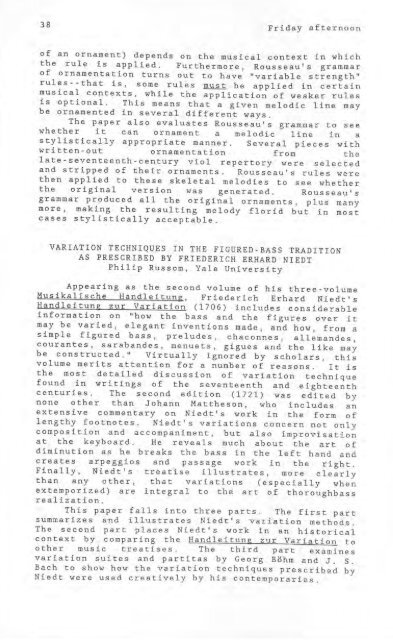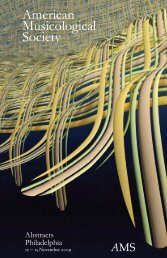Abstracts - American Musicological Society
Abstracts - American Musicological Society
Abstracts - American Musicological Society
Create successful ePaper yourself
Turn your PDF publications into a flip-book with our unique Google optimized e-Paper software.
38 Friday afternoon<br />
of an ornament) depends on the muslcal context in which<br />
al. rule is applied. Furthermore, Rousseau,s grammar<br />
of ornanentation turns out to have,,variable stiength,,<br />
rules - - that is , some rules must be applied in ceriain<br />
musical contexts, while the appiication of weaker rules<br />
is optional. This means thaL a given melodic line nay<br />
be ornanented in several differen-t ways.<br />
The paper also evaluates Rousseaurs grammar to see<br />
whether it can ornanent a rnelodic line in a<br />
stylistically appropriate manner. Several pieces with<br />
written - out ornamentat ion from the<br />
late - seventeenth- century viol repertory lrere selected<br />
and stripped of their ornaments. Rousseau, s rules were<br />
then applied to these skeletal rnelodies to see whether<br />
the original vers ion was generated. Rousseau's<br />
grammar produced all the original ornaments, plus many<br />
more, naking the resulting melody florid but in rnosr<br />
cases stylistically acceptable.<br />
VARIATION TECHNIQUES IN THE FIGURED.BASS TRADITION<br />
AS PRESCRIBED BY FRIEDERICH ERHARD NIEDT<br />
Philip Russom, yale University<br />
Appearing as the second volume of his three_volune<br />
Musikalische Handleitung, Friederich Erhard Niedt,s<br />
Har.rdleitung zur Variation (170d) includes considerabfe<br />
information on "how the bass and the figures over<br />
nay<br />
it<br />
be varied, elegant inventions made, holl,<br />
"rid<br />
from a<br />
simple figured bass, preludes, chaconnes, allemandes,<br />
courantes, sarabandes, menuets, gigues and the like rnay<br />
be constructed. " Virtually ignor-a Uy scholars<br />
volume , this<br />
merits attention for a number of reasons. It is<br />
the most detailed discussion of variation technique<br />
found in writings of the seventeenth and eighteenth<br />
centuries. The second edition (L72L) was edlted by<br />
none other than Johann I,{attheson, who includes an<br />
extensive commentary on Niedt's work in the form of<br />
lengthy footnotes. Niedtrs variations concern not only<br />
composition and accompaninent, but also improvisation<br />
ac the keyboard. He reveals much about the art of<br />
dirninution as he breaks the bass in the left hand and<br />
creates arpeggios and passage work in the right.<br />
Finally, Niedt's treatise illustrates, more clearly<br />
than any other, that variations (especially when<br />
externporized) are integral to the art of thoroughbass<br />
realization.<br />
This paper fa11s into three parts, The first part<br />
summarizes and illustrates Niedt's variation methods.<br />
The second part places Niedt' s work in an historical<br />
context by cornparing the Handleitung zur Variation to<br />
other music treatises. The third part<br />
variation suites and partitas by Georg Bijhrn and """ifr"" J. S.<br />
Bach to show how the variation techniques prescribed by<br />
Niedt were used creatively by his contemporaries.










